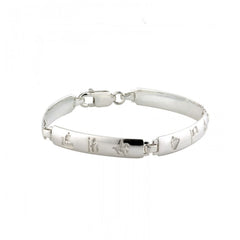History Of Ireland Symbols Explained
One of our most sought-after collections, the History of Ireland range celebrates Ireland’s rich heritage through a series of symbols- each one representing an era or event that left a significant imprint on our history.
From the dawn of Christianity on our island, through to the proclamation of the Republic of Ireland, explore the fascinating events that each of these icons symbolises.
Circle of Life

No beginning, the unwinding path, symbolised by a Celtic swirl, similar to those carved in stone some 5,000 years ago by our ancestors, and are still evident today in Neolithic structures across our beautiful countryside.
Saint Patrick

Saint Patrick, Ireland's patron saint, changed the course of Irish history early in the 5th century when he began his mission of converting Ireland to Christian religion. Saint Patrick has a special importance too as the author of the first document known to have been written in Ireland, he thus marks the transition from an oral to a written literature.
Round Towers

From the 6th century onward, as the Irish people embraced Christianity, great monastic centers were established all over the country. Each site centered around a Round Tower. Probably originally intended as bell-towers, they were soon needed for the storage of food and as places of refuge in times of invasion and persecution.
Vikings

From the 9th to the 11th century the Vikings made repeated attacks around the coast of Ireland. An attempt to gain control of the whole country was defeated by Brian Boru at the Battle of Clontarf in 1014, however the Norsemen retained the towns they had established, notably Dublin, Wexford, Waterford, Cork and Limerick.
Norman Invasion

In the 12th century the invaders were Norman, Flemish and Norman-Welsh, and their language and customs were French. Their 'over-lord' was the French-speaking Henry Angevin, who had, among his many titles, the important one of Henry II of England. This never became a 'Norman Conquest' but was used later as an excuse by the Tudor monarchs of England in their attempts at conquest.
Battle of the Boyne

Protestant King William defeated his father-in-law, Catholic James II at the battle of the Boyne in 1690. In Europe this was seen as an important setback to French King Louis XIV power and in England it signaled the end of the Stuart monarchy. In Ireland the victory assured a Protestant ascendancy which would last for more than two centuries, becoming the cornerstone of the Irish problem today.
United Irishmen

The great religious divide continued to dominate the country a century later, as the catholic community sought more rights feeling that religious division was being used for gain by the ruling Protestant elite. The ultimate goal for the United Irishmen was to separate religion from politics. Originally formed in Belfast, the movement was banned in 1793 by authorities as it grew in popularity but became defunct by 1803 primarily due to three months of sustained and bloody violence following the rising of 1798.
Irish Flag

Ireland’s National Flag, often referred to as the Tricolour, is the distinctive green, white and orange. The green represents Ireland’s older Gaelic traditions and heritage, the orange represents the Protestant supporters of William of Orange and his victory in the Battle of the Boyne. The hope of peace between these two cultures is symbolized by the central band of white. First flown publicly in on March 7th 1848 by a Thomas Francis Meagher, it was not until the 1916 Easter Rising that the tricolour came to be regarded as the National flag of Ireland when it was raised above the GPO in Dublin. This flag is an emblem of inclusion and union of all Ireland's people, regardless of their political beliefs or religion.
The Irish Potato Famine

The potato crops failed repeatedly during the 1840's causing widespread famine. The London government failed to alleviate the suffering, resulting in great bitterness towards the English nation and the ruling landlord classes. The famine was a watershed for the 'Irish' nation, changing forever its outlook and dispersing a large proportion of the population around the world.
Famine Ships

Before the famine the Irish had been reluctant to emigrate, in the decades after the famine Irish emigration figures rose dramatically. Most went to the USA, some to Canada, and the bitterness felt by the Irish in America as well as those left at home had much to do with the subsequent hostile relations between England and Ireland.
GPO

The Republic of Ireland was proclaimed from the General Post Office in Dublin at the start of the Easter Rising, in 1916. The building was almost destroyed by fire and the rising was militarily a failure. The subsequent execution of the leaders of the rising provoked great anger, the Easter Rising thus triggered the War of Independence which eventually brought about the setting up of the modern Irish State. The GPO remains a place of business today, as well as a site of remembrance.
Partition

By the treaty of 1921, which ended the War of Independence, six of the counties of Ulster were separated from the rest of Ireland and became a province of the UK under the title 'Northern Ireland'. The 26 counties became the 'Irish Free State' and in 1948 the Irish Free State became 'The Republic of Ireland'.

History of Ireland Ingot Necklace €112.50

History of Ireland 4 Link Bracelet €199.95

History of Ireland Silver Band €99.95
Shop the full History of Ireland jewellery collection here.
